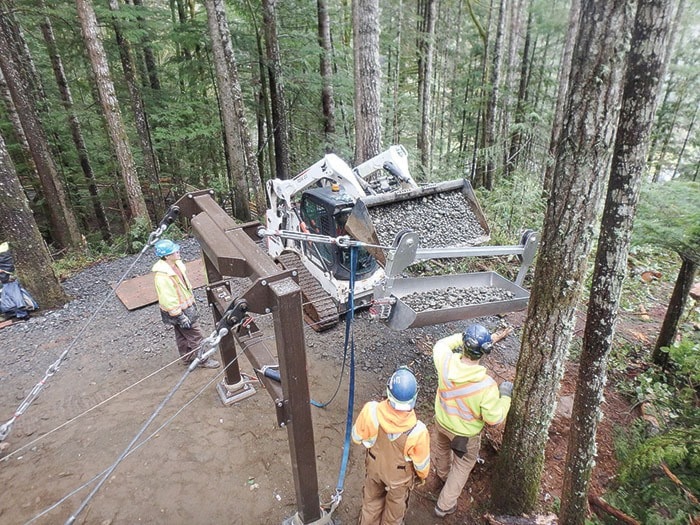Earlier this year the BC Conservation Foundation (BCCF) completed a new skyline, located just downstream of the Elk Falls suspension bridge, to provide gravel placement for salmon habitat in Elk Falls Canyon.
Now that infrastructure is bearing fruit with regularly timed gravel placement
The gravel placement project that will begin Aug. 3 and run through until Aug. 12. Between these dates, a cable skyline will be re-deployed to connect to either side of the canyon. A gravel trolley will ultimately drop about 250 cubic meters of washed spawning gravel into the river below. The gravel will be brought in using existing and new trails using tracked bobcat type machines.
“The John Hart dam stops the natural recruitment of gravel into the canyon from upstream,” says BCCF project lead, Jeramy Damborg. “There’s good fish habitat from the generating station up to Elk Falls. It’s about 1.5 km long and provides spawning and rearing for Steelhead, Coho and Chinook, among other fish. Suitable spawning gravel within the canyon area is a limiting factor to fish production, but since 1999, we have been placing gavel to increase fish productivity.”
The very difficult access with the steep vertical canyon walls has meant the gravel had been historically delivered in buckets by a heavy lift helicopter. No more.
“We plan on delivering gravel to this area annually,” says Damborg. Water releases from the dam disperses the gravel downstream over time.
“We can only tackle the restoration of fish and wildlife in the watershed through community partnerships and this is an example of people and organisations working together to develop those good projects and efficiencies,” says BC Hydro’s Stephen Watson. “Gravel in the canyon can move from year to year, like in December 2014 from those large storms, when BC Hydro spills water for flood risk management. BCCF has put a good method in place to replenish that gravel on a regular basis to help maintain fish habitat.”
“We went through a similar process with the Rotary Club on the suspension bridge project, and while the goals are for fish for this project, the intent is the same – making it more productive and minimizing any impacts to the park as much as possible,” says BC Parks supervisor, Brent Blackmun.
The total project cost is about $61,000. Funding was primarily provided by Fish and Wildlife Compensation Program (FWCP), and the Campbell River Salmon Foundation.
FWCP has been the primary funding source for all six previous gravel projects in the canyon, and is a partnership between BC Hydro, the Province of B.C., Fisheries and Oceans Canada, First Nations and public stakeholders
“We would like to get the word out that moving machinery will be working in the park for this time starting Aug.t 3. “We will have signage and sometimes flaggers to keep the public safe along the trail” There may also be some short trail delays as we move equipment and materials in and out during the gravel operation. Noise during operations is also expected. We appreciate people’s patience and apologise for any inconvenience.”
